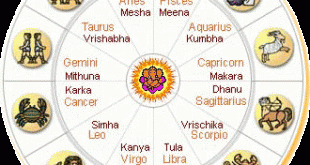The Sanskrit word Nakshatra means “that which does not decay.” The Nakshatras permeate the whole universe and influence the quality of the Rashi in which they are positioned. In the same way the quality of the Graha depends to some extent on the Nakshatra in which it is positioned. The 27 Nakshatras are represented as 27 equal segments of a circle, each covering 13 degrees 20 minutes. The sequence of the 27 Nakshatras begins with Ashvini Nakshatra in Mesha Rashi.
Click below to know more about 27 Nakshatra
• Ashwini • Bharani • Kritika • Rohini • Mrigasira • Aadra • Punarvasu • Pushya • Ashlesha • Magha • PurvaPhalguni • UttaraPhalguni • Hasta • Chitra • Swati • Vishakha • Anuradha • Jyestha • Moola • PurvaAshadha • UttarAshadha • Abhijit • Shravana • Dhanishtha • Satabhisha • PurvaBhadrapada • UttaraBhadrapada • Revati
This illustration shows the sequence of the 27 equal segments of the Nakshatras, each consisting of 13 degrees 20 minutes, with their Sanskrit names and numbers. As seen from the earth, the moon passes through this circle of the 27 Nakshatras in about 27 days.
In Vedic system of astrology, moon has been given the special importance. Moon travels through the sky and revolves around the earth. During this journey, moon travels through all of these nakshatras and at a particular time, it resides in a nakshatra. Moon resides in a nakshatra for approximately one day. Thus it takes the moon about one day to pass through one Nakshatra. The moon is shown here moving through Pushya Nakshatra in Karka Rashi. This example also shows the sun moving through Ashvini Nakshatra in Mesha Rashi. Each of the other planets is also moving through the 27 Nakshatras.
In Vedic astrology , Nakshatra or constellation is one of many factors considered for doing the accurate predictions. These nakshatras are 27 in numbers and together they comprises of 360 degrees in the sky from a fixed point. So the value for each nakshatra is 13 degrees and 20 minutes. The 360 degrees from a fixed point comprises 12 zodiacs And 27 nakshatras. In other words, nakshatra is a further sub-division of zodiac. So this method of prediction using nakshatra is considered more accurate in Indian astrology than the method of prediction using zodiac.
The term Nakshatra is a combination of naks and shetra. In Sanskrit, naks means sky and shetra means region or area. So the meaning of this word is region or area of sky. In Vedic astrology, the predictive system is based on janma nakshatra.
Janma nakshatra is the nakshatra where moon is placed at the time of the birth of the native. Janma nakshatra plays an importance role in deciding the person’s personality, appearance, nature, luck his personal and professional life and level of achievements during his life-span.
Nakshatras are ruled by their respective deities and planets. The respective deities and planets have their impacts on different aspects of the life of the native. The nakshatras are classified on the basis of many aspects. One aspect is on the basis of gender. The nakshatras are male and some are female. The other classification is on the basis of the temperaments and the nakshatras are divided in deva, human and rakhashas category. One more classification is based on the gunas namely rajo, tamo and sato guna.
Nakshatra Pada:
Each Nakshatra is divided into 4 equal parts of 3 degrees 20 minutes each part. These sections/parts are called Nakshatra Charans or Padas 1, 2, 3 and 4. Each Nakshatra Pada has its own significance for interpretation.
 Best and No. 1 Astrology Consultation in India Online Astrology | Kavach | Poojan | Rudraksha
Best and No. 1 Astrology Consultation in India Online Astrology | Kavach | Poojan | Rudraksha






